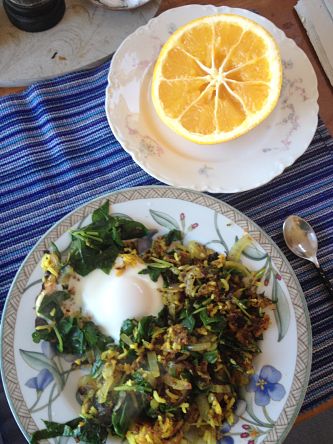 I rarely do two poems by the same poet in a row, but I came across this poem from James Galvin’s latest book and really like it.
I rarely do two poems by the same poet in a row, but I came across this poem from James Galvin’s latest book and really like it.
Category: Recipes
A late summer recipe
 Looking at a row of jars of freshly made jam is a summer pleasure. Especially when the jam is such a lovely golden color. Each year, with pears from my friend’s tree, I make this simple and delicious recipe. The whole thing can be made in a food processor. The citrus cuts the sugar, and the ginger adds spice. Don’t stir much, and don’t overcook, the jam is done just as the pears turn translucent.
Looking at a row of jars of freshly made jam is a summer pleasure. Especially when the jam is such a lovely golden color. Each year, with pears from my friend’s tree, I make this simple and delicious recipe. The whole thing can be made in a food processor. The citrus cuts the sugar, and the ginger adds spice. Don’t stir much, and don’t overcook, the jam is done just as the pears turn translucent.
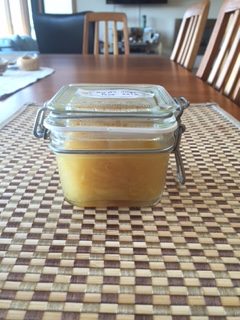 Mother’s Ginger Pear
Mother’s Ginger Pear
4 lbs pears
1 1/2 oranges
1 small lemon
1 2/3 lb sugar
1/4 lb ginger
2 cinnamon sticks
Summer recipe
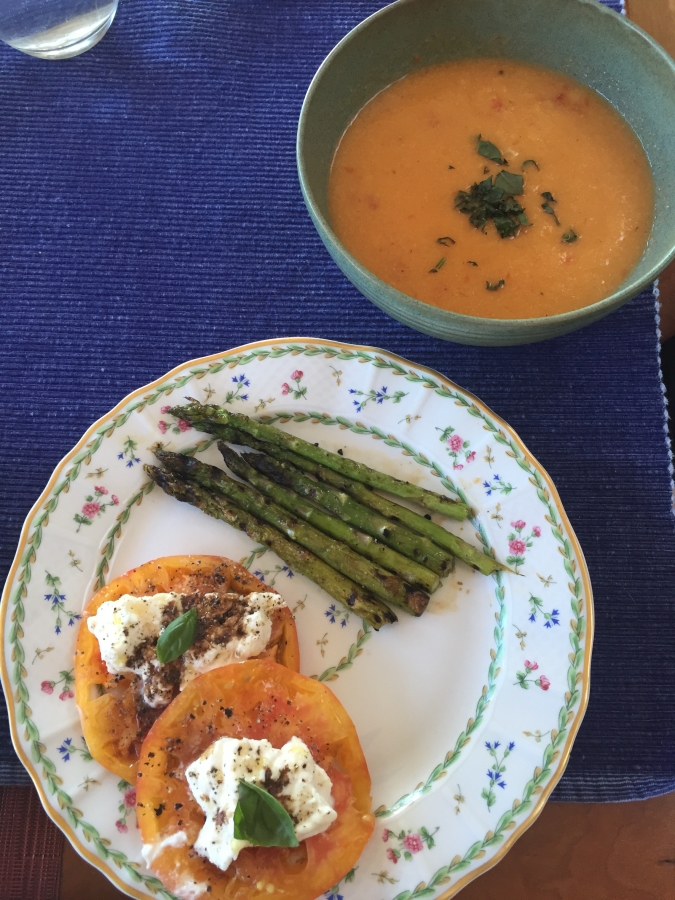 This recipe makes a soup that is like a bowlful of summer.
This recipe makes a soup that is like a bowlful of summer.
I adapted it from one of my favorite cookbooks, Annie Somerville’s Field of Greens. She has you make a vegetarian stock with the corn cobs (adding a potato, some celery, garlic, salt and parsley), which I do if I’m having vegetarians for dinner. But I just cook the corn cobs in a light chicken broth if I’m making it for omnivores, and it works fine. Also, she runs the soup through a food mill. I’ve never had the patience to do that, and it tastes great without. But if you want a satin smooth base, you can do that.
This recipe makes enough for about eight people. It’s yummy and keeps well. But you can easily halve it and have plenty for four. It takes about an hour from start to finish, about half of it “active time” as they say in the world of cookbooks.
Summer Corn and Red Pepper Soup
5 C light chicken stock or water (see below)
1 1/2 T unsalted butter
1 T olive oil
12 medium or 10 large ears of corn (to make 7 Cups of kernels)
2 large or 3 medium red peppers (about 2 1/2 cups, chopped)
1 giant leek or a big white or onion (about 2 cups chopped)
4 large or 8 small garlic cloves
Salt and cayenne or other pepper, toasted ground cumin, green pepper powder
fresh basil Continue reading “Summer recipe”
Two quick chicken recipes
 Once in awhile, it seems like I take whatever is in the fridge and create something tasty. The other night it was leftover rice, a few chicken thighs, some butternut squash, mushrooms, onions, fennel, and green beans. I sautéed the onions and fennel with a little garlic and some spices, added the mushrooms and then set them aside and browned the chicken in the same pan. I layered a pan with the sautéed vegetables and rice, put the chicken and chunks of squash on top and added a bit of chicken stock. I baked them for about twenty-five minutes. While they were baking I lightly sautéed the green beans in the same sauce pan, and then sprinkled them on top. A yummy dinner in less than an hour. Worth saving the idea to make again. Continue reading “Two quick chicken recipes”
Once in awhile, it seems like I take whatever is in the fridge and create something tasty. The other night it was leftover rice, a few chicken thighs, some butternut squash, mushrooms, onions, fennel, and green beans. I sautéed the onions and fennel with a little garlic and some spices, added the mushrooms and then set them aside and browned the chicken in the same pan. I layered a pan with the sautéed vegetables and rice, put the chicken and chunks of squash on top and added a bit of chicken stock. I baked them for about twenty-five minutes. While they were baking I lightly sautéed the green beans in the same sauce pan, and then sprinkled them on top. A yummy dinner in less than an hour. Worth saving the idea to make again. Continue reading “Two quick chicken recipes”
Best Beans
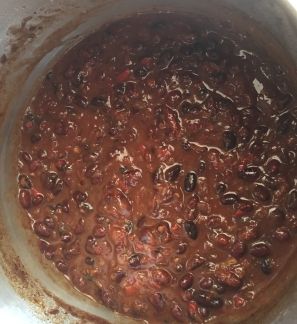 Instead of a vision of sugarplums, how about a simple, inexpensive and wonderful meal that lasts for days. I set myself the challenge of making a pot of vegetarian beans that taste as good as ones cooked with a ham hock.
Instead of a vision of sugarplums, how about a simple, inexpensive and wonderful meal that lasts for days. I set myself the challenge of making a pot of vegetarian beans that taste as good as ones cooked with a ham hock.
First I made a rich vegetable stock: two whole ears of corn (chopped), turnip, rutabaga, golden beet, red pepper, carrot, onion, celery, herbs, simmered about two hours and strained. I rinsed the beans (I used black beans), brought them to a boil, and drained them. (Someone told me this reduces their gas-producing quality.) Then I cooked the beans in the stock with chopped early girl tomatoes, shallots, onions, garlic, and a chipotle pepper for about 40 minutes in the pressure cooker. After they were soft, I added cumin, chiles, cilantro, lime, salt.
These may be the most flavorful beans I ever made. We ate them with rice and chile verde, with eggs, and by themselves. Yum!
Thinking about stock
Yesterday, as I made stock out of my two newly butchered hens, I decided to read about stock in Serious Eats. My stock method is mostly just throw whatever scraps I have into the pot and simmer for hours. But these were special chickens–gorgeous, rich meat and fat–and I wanted to do right by them.
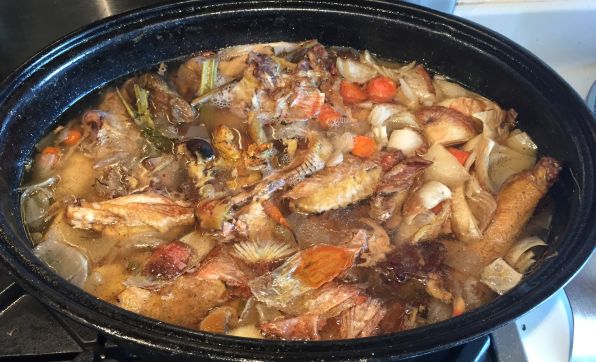 I’d tried J. Kenji López-Alt’s method of chopping chicken into tiny bits, but it made a total charnal house of my kitchen, so I wanted to explore what else they suggested. Daniel Gritzner had a comprehensive article, and the comments about using a pressure cooker or bringing the stock to a boil then setting it in a 225 degree oven overnight interested me. I’m also going to try adding an apple with the onions, carrots, etc. The most interesting idea to me was to use one stock as a base to make another stock, layering and enriching the flavor. I’m definitely going to try that. Continue reading “Thinking about stock”
I’d tried J. Kenji López-Alt’s method of chopping chicken into tiny bits, but it made a total charnal house of my kitchen, so I wanted to explore what else they suggested. Daniel Gritzner had a comprehensive article, and the comments about using a pressure cooker or bringing the stock to a boil then setting it in a 225 degree oven overnight interested me. I’m also going to try adding an apple with the onions, carrots, etc. The most interesting idea to me was to use one stock as a base to make another stock, layering and enriching the flavor. I’m definitely going to try that. Continue reading “Thinking about stock”
Summer food
Tomatoes and corn, sweet onions, greens, soft cheeses. That’s what I’m eating these days. Here’s a typical menu:
Polenta with fresh corn kernels
Tomato sauce
Grilled fish or pulled pork
Greek salad
 I make the tomato sauce and polenta, then serve them like this with, some protein in the middle (or not). See below for a peek at a wonderful gadget I use that stirs the polenta for me while I’m doing other things.
I make the tomato sauce and polenta, then serve them like this with, some protein in the middle (or not). See below for a peek at a wonderful gadget I use that stirs the polenta for me while I’m doing other things.
Here are some recipes:
Simplest tomato sauce: Sauté an onion, a little garlic, chopped fresh basil in olive oil. Chop about a dozen of the ripest, best tomatoes around. Add them in. If you want, puree a few more, and add those. More basil, salt, oregano. Simmer.
Meanwhile, make a little polenta with 4 parts milk, one part water. (4 cups liquid to a little less than 1 cup of polenta.) Stir to avoid lumps. Add a few tablespoons butter and kernels from an ear or two of corn. You can add a little cheese if you like it cheesy. Cook till creamy.
Serve sauce over polenta. You can add anything you might want for protein in the middle of the sauce.
Greek salad: peel and chop a cucumber into chunks, add chunked tomato, sliced red onion, some crumbled feta. Sprinkle with fresh oregano, salt pepper, olive oil and red wine vinegar.
The perfect poached egg
 I’ve tried many methods to poach eggs, but this one seems foolproof, from Julia Child via the NY Times:
I’ve tried many methods to poach eggs, but this one seems foolproof, from Julia Child via the NY Times:
Bring a small pot of water to a boil. Have a bowl of ice water at hand. Punch a tiny hole in the end of the egg(s). Gently place the egg(s) into fully boiling water for 10 seconds. Transfer the egg(s) to the ice water. Crack the egg(s) into a small bowl and slide into the boiling water one at a time. Turn off the water. Remove when poached to your satisfaction (for me, about 3 minutes).
Update to the Great Turkey Test
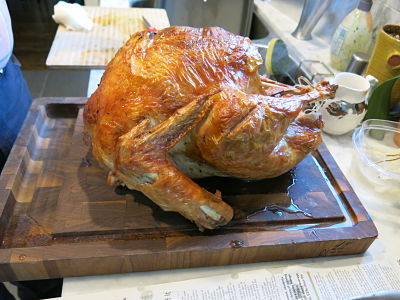 Before the New Year, I posted the results of my turkey experiments based on J. Kenji López-Alt’s ideas for spatchcocking and baking stone approaches. But for my last experiment, I combined the baking stone with a method I learned from the late Marshall Harrison, owner and chef of a famed Connecticut steak house (and my cousin by marriage). His method was to put the whole bird on a rack over an inch or two of liquid in a tightly covered pan. The pan should be airtight–or at least have a very tightly fitting lid. I bought a good tight-fitting large roasting pan years ago from a restaurant supply company. You heat the oven to 500 degrees, steam the bird, then turn down to 450 and let it brown. Continue reading “Update to the Great Turkey Test”
Before the New Year, I posted the results of my turkey experiments based on J. Kenji López-Alt’s ideas for spatchcocking and baking stone approaches. But for my last experiment, I combined the baking stone with a method I learned from the late Marshall Harrison, owner and chef of a famed Connecticut steak house (and my cousin by marriage). His method was to put the whole bird on a rack over an inch or two of liquid in a tightly covered pan. The pan should be airtight–or at least have a very tightly fitting lid. I bought a good tight-fitting large roasting pan years ago from a restaurant supply company. You heat the oven to 500 degrees, steam the bird, then turn down to 450 and let it brown. Continue reading “Update to the Great Turkey Test”
Rainy Sunday
Here in rainless Northern California, I woke gratefully to the sound of rain. The chickens may not be happy about it, but it is such a relief to be having a normal winter day. Luckily, in yesterday’s brilliant sun I did a bunch of yard work including cleaning the chicken coop, so at least they are cozy.
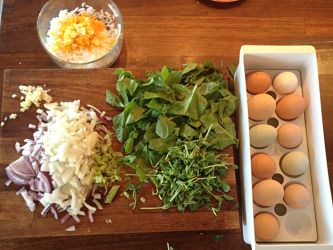 And they are laying. Here were the ingredients for yesterday’s breakfast, although I only used two of the eggs. It made for a delicious start to the day.
And they are laying. Here were the ingredients for yesterday’s breakfast, although I only used two of the eggs. It made for a delicious start to the day.
The wonderful, golden Cocktail Grapefruit are in season now, a very sweet grapefruit with a zillion seeds, but worth it. Add grapefruit, and breakfast looked like this.
Then I decided to try the hot and sour soup recipe from Serious Eats, by J. Kenji López. I was interested to try his technique for rapid chicken broth, which involves hacking chicken parts into bits, blanching them first, and then cooking with a hambone and “aromatics” (onion, garlic, scallions, ginger).
It worked–excellent broth in a little over an hour, but it involves turning your kitchen into an abattoir, little bits of chicken parts flying everywhere. There’s a reason butchers are always pictured in those blood-smeared white smocks. Definitely not for the faint of heart. Maybe Kenji knows a way to do this without the grisly bit dispersion, but if so, he doesn’t mention it. nInstead he says “Hack your chicken carcasses to bits before making stock. Not only will it make you feel like a medieval viking-style badass, but it’ll also make your broth come together much faster. The more finely you chop the bones, the more surface area they have, and the more channels for proteins, minerals, and other goodies to get extracted into the broth.” So caveat cook.
Because this recipe required a specific Chinese fermented rice vinegar (“essential to the flavor”), I had to head down to the Asian mall, and as it was Saturday and just after Chinese New Year, I encountered a drumming, whistling band and leaping tigers:
Very loud, cheerful and colorful, which made up for the crowds and the ordeal involved in buying my slim bottle of vinegar.
The soup is really delicious, if anyone wants a lovely rainy day project.
The magic of stock
 I’ve written a lot about making stock and even included a basic recipe, but as many of you are wondering what to do with that turkey carcass taking up a good chunk of a shelf in your refrigerator, it seemed like a good time to recap some tips for turning it into cook’s gold. This is really how I think of good stock, because it adds a depth of flavor to soups, stews, and sauces that you can’t get otherwise.
I’ve written a lot about making stock and even included a basic recipe, but as many of you are wondering what to do with that turkey carcass taking up a good chunk of a shelf in your refrigerator, it seemed like a good time to recap some tips for turning it into cook’s gold. This is really how I think of good stock, because it adds a depth of flavor to soups, stews, and sauces that you can’t get otherwise.
If you want a light stock, just break up the carcass and miscellaneous bones and cover them in water in a good size pot. (If you like a darker flavor, roast the carcass in the oven first to brown it.) Continue reading “The magic of stock”
Salad for supper
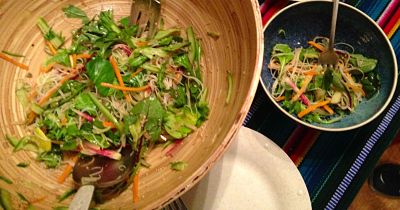 We had a party last night, and as we were finishing up the salad, two blog followers urged me to put the recipe on the blog. I had to hurry up and take a picture before we ate the last bit. Sorry there wasn’t much left!
We had a party last night, and as we were finishing up the salad, two blog followers urged me to put the recipe on the blog. I had to hurry up and take a picture before we ate the last bit. Sorry there wasn’t much left!
